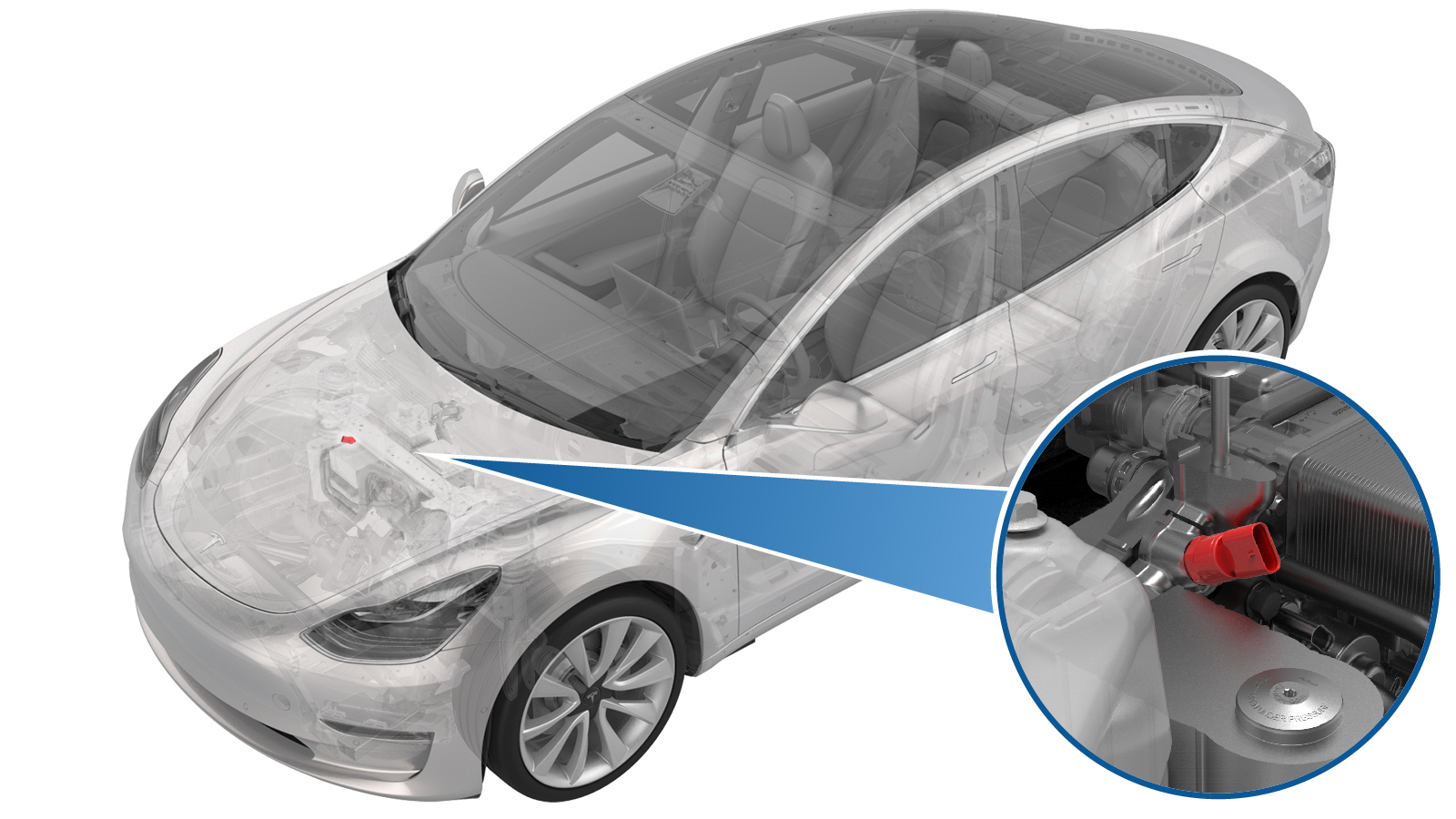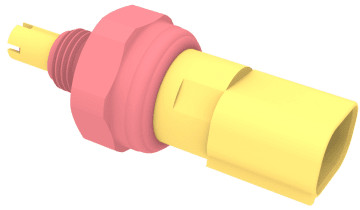Sensor - Pressure and Temperature (PT) - Low Pressure (Heat Pump) (Remove and Replace)
 Correction code
18400402
0.30
NOTE: Unless otherwise explicitly
stated in the procedure, the above correction code and FRT reflect all of the work
required to perform this procedure, including the linked procedures. Do not stack correction codes unless
explicitly told to do so.
NOTE: See Flat Rate
Times to learn more about FRTs and how they are created. To provide feedback on
FRT values, email ServiceManualFeedback@tesla.com.
NOTE: See Personal Protection to make sure wearing proper PPE when
performing the below procedure. See Ergonomic Precautions for safe and healthy working practices.
Correction code
18400402
0.30
NOTE: Unless otherwise explicitly
stated in the procedure, the above correction code and FRT reflect all of the work
required to perform this procedure, including the linked procedures. Do not stack correction codes unless
explicitly told to do so.
NOTE: See Flat Rate
Times to learn more about FRTs and how they are created. To provide feedback on
FRT values, email ServiceManualFeedback@tesla.com.
NOTE: See Personal Protection to make sure wearing proper PPE when
performing the below procedure. See Ergonomic Precautions for safe and healthy working practices.
- 2023-04-04: Updated A/C oil type to be used with reference to Fluids and Capacities for A/C oil specifications.
- 2024-02-01: Updated the way of performing the routines from using Toolbox to using the touchscreen.
Torque Specifications
| Description | Torque Value | Recommended Tools | Reuse/Replace | Notes |
|---|---|---|---|---|
| Low Pressure and Temperature Sensor |
 9 Nm (6.6 lbs-ft) |
|
N/A |
|
Remove
- Open the LH front door and lower the LH front window.
- Place the vehicle in Service Mode by using the touchscreen. See Service Mode.
- Remove the underhood storage unit. See Underhood Storage Unit (Remove and Replace).
- Unlock the vehicle gateway. See Gateway (Unlock).
- On the touchscreen, tap the Service Mode "wrench" (at the bottom of the touchscreen UI), and then tap , and allow the routine to complete.
-
Recover the A/C refrigerant
(refrigerant only). See Recovery (Heat Pump Model 3) or Recovery (Original Model 3).
NoteCompletely recover the refrigerant before continuing this procedure.
-
Release the locking tab, and
then disconnect the electrical connector from the low pressure temperature
sensor.
CAUTIONDO NOT push down on the red locking tab. Pull the tab away from the connector until the connector is unlocked, and then continue pulling the main body of the connector to fully disconnect it.
-
Use the P/T sensor socket to
remove the low pressure temperature sensor from the supermanifold.
CAUTIONUse only hand tools to remove the PT sensor. Impact or power tools will break the threads.CAUTIONUse only the P/T sensor socket to remove the sensor. Using other tools can damage the sensor.NoteFor Sensata sensors, use the 24mm thin wall P/T sensor socket (1600833-00-A). For Bridgeport sensors, use the 21mm P/T sensor socket (1565836-00-A).TIpUse of the following tool(s) is recommended:
- 1565836-00-A - GEN 1 P/T SENSOR SOCKET, 21MM
- 1600833-00-A - GEN 2 P/T SENSOR SOCKET, 24MM
- Flex head ratchet/flex head torque wrench
- 3 in extension
- Record the part numbers and serial numbers of the old and new sensors in the repair order.
Install
- Lubricate the new low pressure temperature sensor threads and O-ring with the appropriate A/C oil. See Fluids and Capacities for A/C oil specifications.
-
Install and hand-tighten the low pressure temperature sensor until the
sensor O-ring just makes contact with the Supermanifold.
NoteUse an inspection mirror to visualize this and subsequent steps.
- Manually back off and tighten the low pressure temperature sensor in an incremental manner so that the sensor O-ring properly slides into the chamfer in the Supermanifold.
- If the low pressure temperature sensor O-ring appears to pinch, or no longer slides into the chamfer, stop and reverse thread the sensor until the O-ring no longer appears to be pinched.
-
Continue to back off and tighten the low pressure temperature sensor until
the O-ring slides completely into the chamfer and is no longer
visible.
NoteThere should be no gap, and the sensor body should be bottomed out against the Supermanifold.
-
Use the P/T sensor socket to tighten
the low pressure temperature sensor to the specified torque value.
 9 Nm (6.6 lbs-ft)CAUTIONUse only hand tools to install the PT sensor. Impact or power tools will break the threads.CAUTIONUse only the P/T sensor socket to install the sensor. Using other tools can damage the sensor.NoteFor Sensata sensors, use the 24mm thin wall P/T sensor socket (1600833-00-A). For Bridgeport sensors, use the 21mm P/T sensor socket (1565836-00-A).TIpUse of the following tool(s) is recommended:
9 Nm (6.6 lbs-ft)CAUTIONUse only hand tools to install the PT sensor. Impact or power tools will break the threads.CAUTIONUse only the P/T sensor socket to install the sensor. Using other tools can damage the sensor.NoteFor Sensata sensors, use the 24mm thin wall P/T sensor socket (1600833-00-A). For Bridgeport sensors, use the 21mm P/T sensor socket (1565836-00-A).TIpUse of the following tool(s) is recommended:- 1565836-00-A - GEN 1 P/T SENSOR SOCKET, 21MM
- 1600833-00-A - GEN 2 P/T SENSOR SOCKET, 24MM
- Flex head ratchet/flex head torque wrench
- 3 in extension
-
Connect the electrical
harness to the low pressure temperature sensor, and then engage the locking
tab.
CAUTIONPush the red locking tab towards the connector to engage the locking mechanism. DO NOT push down or pull up on the red locking tab.
- Perform the vacuum leak test and oil injection. See Vacuum Leak Test and Oil Injection (Heat Pump Model 3).
-
Recharge the A/C refrigerant. See
Recharge (Heat Pump Model 3) or Recharge (Original Model 3).
NoteDo not disconnect the laptop from the vehicle yet.
- If a refrigerant leak detector is available, make sure that there is no leak at the low pressure temperature sensor.
- On the touchscreen, tap the Service Mode "wrench" (at the bottom of the touchscreen UI), and then tap , and close once the routine is passed.
- Tap , and close once the routine is passed.
- Tap , and close once the routine is passed.
- Exit Service Mode. See Service Mode.
- Install the underhood storage unit. See Underhood Storage Unit (Remove and Replace).